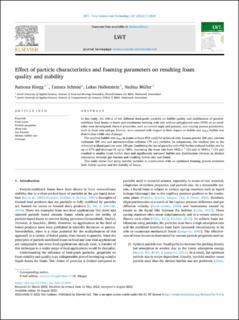Please use this identifier to cite or link to this item:
https://doi.org/10.21256/zhaw-25517Full metadata record
| DC Field | Value | Language |
|---|---|---|
| dc.contributor.author | Rüegg, Ramona | - |
| dc.contributor.author | Schmid, Tamara | - |
| dc.contributor.author | Hollenstein, Lukas | - |
| dc.contributor.author | Müller, Nadina | - |
| dc.date.accessioned | 2022-08-29T08:57:13Z | - |
| dc.date.available | 2022-08-29T08:57:13Z | - |
| dc.date.issued | 2022-09-15 | - |
| dc.identifier.issn | 0023-6438 | de_CH |
| dc.identifier.uri | https://digitalcollection.zhaw.ch/handle/11475/25517 | - |
| dc.description | Highlights: • Use of particles without emulsifier reduced median bubble size and improved foam stability. • Combining PGE emulsifier and particles resulted in higher foam stability. • Particularly low drainage was observed in particle stabilized foams using banana powder. • Increases in particle size and wetting angle correlated with reduced drainage. • High shear rates were strongly associated with narrower bubble size distributions. | de_CH |
| dc.description.abstract | In this study, the effects of ten different food-grade particles on bubble quality and stabilization of particle-stabilized food foams in batch and continuous foaming with and without polyglycerol ester (PGE) as an emulsifier were investigated. Particle properties, such as contact angle and porosity, and varying process parameters, such as shear rate and gas fraction, were assessed with respect to their impact on bubble size x50,0, bubble size distribution width and drainage. The smallest bubble size x50,0 in foams without PGE could be achieved with banana powder (88 μm), calcium carbonate (89 μm) and microcrystalline cellulose (79 μm) particles. In comparison, the smallest size in the reference without particles were 105 μm. Combining the use of particles with PGE further reduced bubble size by up to 57% and drainage by up to 100%. Increasing the shear rate from 4922 s−1 (35 μm) to 9844 s−1 (14 μm) resulted in smaller mean bubble sizes and significantly narrower bubble size distributions whereas no distinct correlation between gas fraction and resulting bubble size was found. This study shows that using suitable particles in combination with an optimized foaming process promotes both bubble quality and the stability of foams. | de_CH |
| dc.language.iso | en | de_CH |
| dc.publisher | Elsevier | de_CH |
| dc.relation.ispartof | LWT - Food Science and Technology | de_CH |
| dc.rights | http://creativecommons.org/licenses/by/4.0/ | de_CH |
| dc.subject | Food foam | de_CH |
| dc.subject | Particle property | de_CH |
| dc.subject | Shear rate | de_CH |
| dc.subject | Gas fraction | de_CH |
| dc.subject | Median bubble size | de_CH |
| dc.subject | Drainage | de_CH |
| dc.subject.ddc | 664: Lebensmitteltechnologie | de_CH |
| dc.title | Effect of particle characteristics and foaming parameters on resulting foam quality and stability | de_CH |
| dc.type | Beitrag in wissenschaftlicher Zeitschrift | de_CH |
| dcterms.type | Text | de_CH |
| zhaw.departement | Life Sciences und Facility Management | de_CH |
| zhaw.organisationalunit | Institut für Computational Life Sciences (ICLS) | de_CH |
| zhaw.organisationalunit | Institut für Lebensmittel- und Getränkeinnovation (ILGI) | de_CH |
| dc.identifier.doi | 10.1016/j.lwt.2022.113859 | de_CH |
| dc.identifier.doi | 10.21256/zhaw-25517 | - |
| zhaw.funding.eu | No | de_CH |
| zhaw.issue | 113859 | de_CH |
| zhaw.originated.zhaw | Yes | de_CH |
| zhaw.publication.status | publishedVersion | de_CH |
| zhaw.volume | 167 | de_CH |
| zhaw.publication.review | Peer review (Publikation) | de_CH |
| zhaw.webfeed | Datalab | de_CH |
| zhaw.webfeed | LM-Technologie | de_CH |
| zhaw.webfeed | Simulation and Optimization | de_CH |
| zhaw.funding.zhaw | PiFoBake: Mechanisch und thermisch hochstabile partikelstabilisierte Schäume für die Anwendung in glutenfreien Backwaren | de_CH |
| zhaw.author.additional | No | de_CH |
| zhaw.display.portrait | Yes | de_CH |
| Appears in collections: | Publikationen Life Sciences und Facility Management | |
Files in This Item:
| File | Description | Size | Format | |
|---|---|---|---|---|
| 2022_Rueegg-etal_Effect-particle-characteristics-foaming-parameters.pdf | 3.56 MB | Adobe PDF |  View/Open |
Show simple item record
Rüegg, R., Schmid, T., Hollenstein, L., & Müller, N. (2022). Effect of particle characteristics and foaming parameters on resulting foam quality and stability. LWT - Food Science and Technology, 167(113859). https://doi.org/10.1016/j.lwt.2022.113859
Rüegg, R. et al. (2022) ‘Effect of particle characteristics and foaming parameters on resulting foam quality and stability’, LWT - Food Science and Technology, 167(113859). Available at: https://doi.org/10.1016/j.lwt.2022.113859.
R. Rüegg, T. Schmid, L. Hollenstein, and N. Müller, “Effect of particle characteristics and foaming parameters on resulting foam quality and stability,” LWT - Food Science and Technology, vol. 167, no. 113859, Sep. 2022, doi: 10.1016/j.lwt.2022.113859.
RÜEGG, Ramona, Tamara SCHMID, Lukas HOLLENSTEIN und Nadina MÜLLER, 2022. Effect of particle characteristics and foaming parameters on resulting foam quality and stability. LWT - Food Science and Technology. 15 September 2022. Bd. 167, Nr. 113859. DOI 10.1016/j.lwt.2022.113859
Rüegg, Ramona, Tamara Schmid, Lukas Hollenstein, and Nadina Müller. 2022. “Effect of Particle Characteristics and Foaming Parameters on Resulting Foam Quality and Stability.” LWT - Food Science and Technology 167 (113859). https://doi.org/10.1016/j.lwt.2022.113859.
Rüegg, Ramona, et al. “Effect of Particle Characteristics and Foaming Parameters on Resulting Foam Quality and Stability.” LWT - Food Science and Technology, vol. 167, no. 113859, Sept. 2022, https://doi.org/10.1016/j.lwt.2022.113859.
Items in DSpace are protected by copyright, with all rights reserved, unless otherwise indicated.